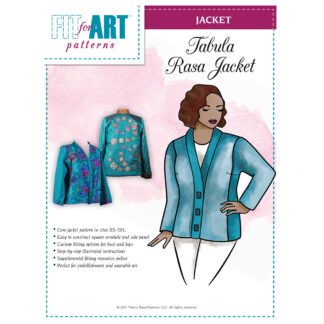
Continuing with our theme of sewing cozy garments for winter wear at home, today’s focus is on Carrie’s newest flannel shirt. Last year I made a flannel Shirt Variation with a stand-up collar and curved cuff with a piece of JoAnn’s plaid flannel. A few weeks ago I dipped into my stash and found 2 yards of black and white check flannel, also purchased at JoAnn’s. This time I decided to use Jean Jacket Variations for the Tabula Rasa Jacket as the basis for my flannel shirt, choosing the classic collar and cuff.
Why Jean Jacket Variations?
Why Jean Jacket rather than Shirt Variations, you ask? Here are a couple of reasons. One, I wanted to try using the two-piece sleeve pattern with placket and cuff on an everyday shirt. Two, I like the “self facing” technique of turning the center front in to create the front facing for buttons and buttonholes. (I used the same technique a few years ago when making my Fit for Travel shirt with snap closures.) Jean Jacket Variations for the TRJ includes both of these features.
Since I didn’t intend to emphasize decorative topstitching, as I did on my Classic Jean Jacket, I decided to simplify the shirt layout and construction with fewer pieces. I simply attached the Jean Jacket Front Template to my core Tabula Rasa Jacket front pattern without subdividing the pattern into a yoke and two lower front pieces and cut two fronts .
Yoke for Back Detail
For the Back, I used my Jean Jacket back yoke and lower back patterns, without subdividing the lower back into three panels. Because I was making an everyday shirt in just one fabric, I decided to add some interest by turning the checks on an angle in several elements. The back yoke was an easy place to add detail to the back by cutting on the bias. I cut out two yokes (one to use as a back facing for extra support) and followed this easy construction method:
- The lower back is sandwiched between the two yokes and all three layers stitched together.
- After grading the seam allowances, both yokes were pressed up.
- The yoke seam was stitched with two rows of topstitching to mimic the flat fell seams elsewhere in the shirt.
Finally, I used the flat fell seam technique described in Jean Jacket Variations to cleanly finish the shoulder seam when joining the front and backs, incorporating all three seam allowances. Because I didn’t use a contrast thread, it is hard to see the difference here but I am trying to show you the right side of the shoulder seam and wrong side – it creates a very clean finish!
Front Placket and Collar
The rest of the shirt construction followed the Jean Jacket instructions. Here you can see the preparation of the fronts by folding and pressing the center front extension twice to create a front placket. The front placket is stitched in the upper corner, clipped, and turned right side out to create a small notch below the collar.
Of course I wanted to repeat my use of the black and white checks cut on the bias in a few other places on the shirt. To determine the best way to repeat the angled checks on the collar, I cut out one collar on the bias and one on the straight of grain. Which direction would you choose?
After testing the look of the collar laid against the shirt front, I preferred the straight of grain collar. It actually appeared to be on the bias in front and also created a better contrast against the back yoke.
Sleeve and Cuff Detail
The two piece sleeve’s placket is formed by turning under an extension on each piece, similar to the self-facing front. I sewed the seam joining the two sleeve sections with the “faux” flat fell seam technique, also described in Jean Jacket Variations, which makes it easy to finish the sleeve plackets. Baste in the sleeve pleats and try the shirt on to make sure you are getting a comfortable fit and length before attaching the cuffs. It’s also smart to check the cuff length against your sleeve opening at this stage as you may need to make adjustments for any fit changes you’ve made to the sleeve. I certainly did! As you can see, I repeated the bias cut detail on the classic cuffs.
Pockets!
Finally, I carried the checks on bias to the front of the shirt by adding patch pockets. You can find simple patch pocket patterns and directions in Pocket Variations for the Tabula Rasa Jacket, an easy download pattern.
This flannel shirt is already a go-to favorite! It is soft and warm and a relaxed, untailored fit by design. What are you sewing up for cozy winter wear?
Be sure to keep an eye on our social media this week for more flannel details and inspiration.
Stay safe and Sew happy! Carrie




























These variations are great and something I’ll definitely try out. Thanks for your wonderful creativity and sharing.
Love how great your shirt turned out. What a wonderful new way to use the jeans jacket for this variation. Your clear directions and pictures are so much appreciated. Now I can’t wait to sew my mock-up. Many thanks.